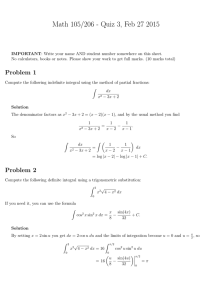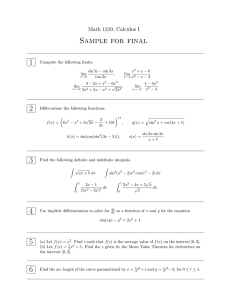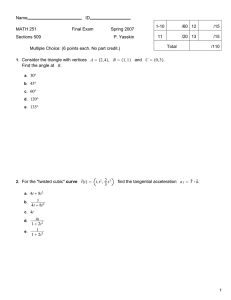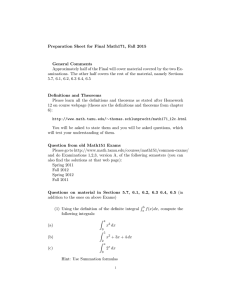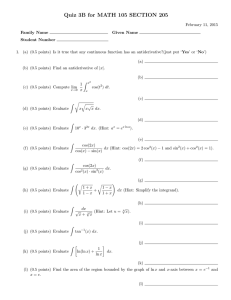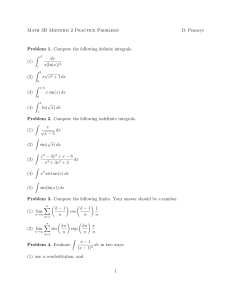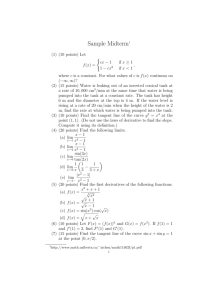here
advertisement
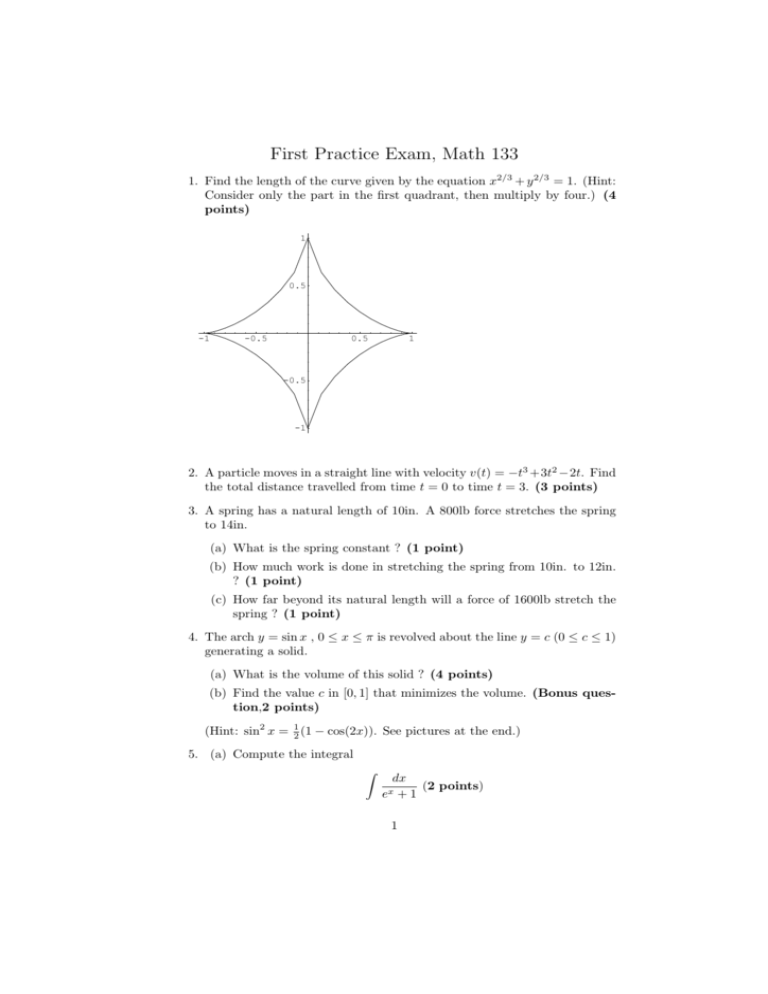
First Practice Exam, Math 133 1. Find the length of the curve given by the equation x2/3 + y 2/3 = 1. (Hint: Consider only the part in the first quadrant, then multiply by four.) (4 points) 1 0.5 -1 -0.5 1 0.5 -0.5 -1 2. A particle moves in a straight line with velocity v(t) = −t3 +3t2 −2t. Find the total distance travelled from time t = 0 to time t = 3. (3 points) 3. A spring has a natural length of 10in. A 800lb force stretches the spring to 14in. (a) What is the spring constant ? (1 point) (b) How much work is done in stretching the spring from 10in. to 12in. ? (1 point) (c) How far beyond its natural length will a force of 1600lb stretch the spring ? (1 point) 4. The arch y = sin x , 0 ≤ x ≤ π is revolved about the line y = c (0 ≤ c ≤ 1) generating a solid. (a) What is the volume of this solid ? (4 points) (b) Find the value c in [0, 1] that minimizes the volume. (Bonus question,2 points) (Hint: sin2 x = 21 (1 − cos(2x)). See pictures at the end.) 5. (a) Compute the integral Z dx (2 points) +1 ex 1 (Hint: Consider the integral integral) R ex ex +1 dx first, and use it for the given (b) Compute the derivative of f (x) = x (c) Compute √ x (2 points) µ ¶x/2 1 1+ (2 points) x→+∞ x lim TOTAL: 20 POINTS 2 Figure 1: Problem 4–The function and the axis of rotation Figure 2: Problem 4–The solid of revolution 3 Solutions 1. We solve the equation x2/3 + y 2/3 = 1 for y and obtain y = (1 − x2/3 )3/2 so that y0 = = 2 3p − x−1/3 · 1 − x2/3 3 2 p −x−1/3 1 − x2/3 and p q 1 + (y 0 )2 1 + x−2/3 (1 − x2/3 ) p = x−2/3 −1/3 = x . = The length of the curve in the first quadrant is then given by Z 1 Z 1p 0 2 1 + (y ) dx = x−1/3 dx 0 0 = = ¯1 3 2/3 ¯¯ x ¯ 2 0 3 2 and the length of the whole curve then equals 6. 2. We first have to figure out where the velocity is positive and where it is negative on the interval 0 ≤ t ≤ 3. We solve 0 = −t3 + 3t2 − 2t = v(t). One solution is t = 0. In order to look for nonzero solutions we divide the above equation by t and solve 0 = −t2 + 3t − 2 which has the solutions t = 1 and t = 2. Inserting arbitrary values from the open intervals (0, 1), (1, 2) and (2, 3) we see that negative if 0 < x < 1 positive if 1 < x < 2 . v(t) is negative if 2 < x < 3 The total distance travelled is then given by Z 1 Z 2 Z S=− v(t)dt + v(t)dt − 0 1 4 2 3 v(t)dt. We have Z v(t)dt = − t4 + t3 − t2 4 so that ¶¯1 µ 4 ¶¯2 ¯ ¯ t t4 3 2 ¯ 3 2 ¯ −t +t ¯ + − +t −t ¯ + 4 4 0 1 µ 4 ¶¯3 ¯ t + − t3 + t2 ¯¯ 4 2 1 1 81 +0+ + − 27 + 9 − 0 4 4 4 83 − 18 4 11 . 4 µ S = = = = 3. (a) The spring constant is given by k = 800/4 = 200[lb/in]. (b) Z 2 W = 0 200x dx = 100x2 |20 = 400[lb · in]. (c) Using again F = kx we obtain x = F/k = 1600/200 = 8[in], so that the spring is stretched 8 inches beyond its natural length. 4. (a) We move the whole picture down by c units, replacing the sine function with ” sin x − c”. Hence the volume of the solid is given by Z π V = π (sin x − c)2 dx 0 Z π = π (sin2 x − 2c sin x + c2 )dx 0 Z π π (1 − cos(2x))dx − = 2 0 Z π −2cπ sin xdx + π 2 c2 0 Z π2 π π = − cos(2x)dx + 2 2 0 +2cπ cos x|π0 + π 2 c2 5 π2 π − sin(2x)|π0 + 2 4 +2cπ(−1 − 1) + π 2 c2 π2 − 4cπ + π 2 c2 . 2 = = (b) The volume V depends on the parameter c, V (c) = π2 − 4cπ + π 2 c2 . 2 In order to look for a minimum inside the interval [0, 1] we have to solve 0 = V 0 (c) = 2cπ 2 − 4π. This is satisfied for c = 2/π which lies between 0 and 1. Since V 00 (c) = 2π 2 > 0 the volume of the solid is minimal for c = 2/π. 5. (a) Substituting u = ex + 1 and du = ex dx we get Z Z ex du dx = = ln|u| + C = ln(ex + 1) + C ex + 1 u since u = ex + 1 > 0. Then note that 1 1 + ex − ex 1 + ex ex ex = = − = 1 − ex + 1 ex + 1 ex + 1 ex + 1 ex + 1 so that Z dx = x e +1 Z Z dx − ex dx = x − ln(ex + 1) + const. ex + 1 (b) By definition of the exponential function we have √ x f (x) = x √ =e x ln x and f 0 (x) √ ¶ ln x x √ + x 2 x µ ¶ √ ln x 1 √ +√ = x x 2 x x = e √ x ln x (c) Let f (x) := so that µ µ ¶x/2 1 1+ x ¡ ¢ µ ¶ ln 1 + x1 x 1 ln(f (x)) = ln 1 + = . 2 2 x x 6 We compute the limit using l’Hôpital’s rule: lim ln(f (x)) = x→+∞ so that −1 1 1 x2 1+ x 2 x→+∞ − 2 x lim = 1 x→+∞ 2 + lim µ ¶x/2 √ 1 lim 1+ = e1/2 = e. x→+∞ x 7 2 x = 1 2
